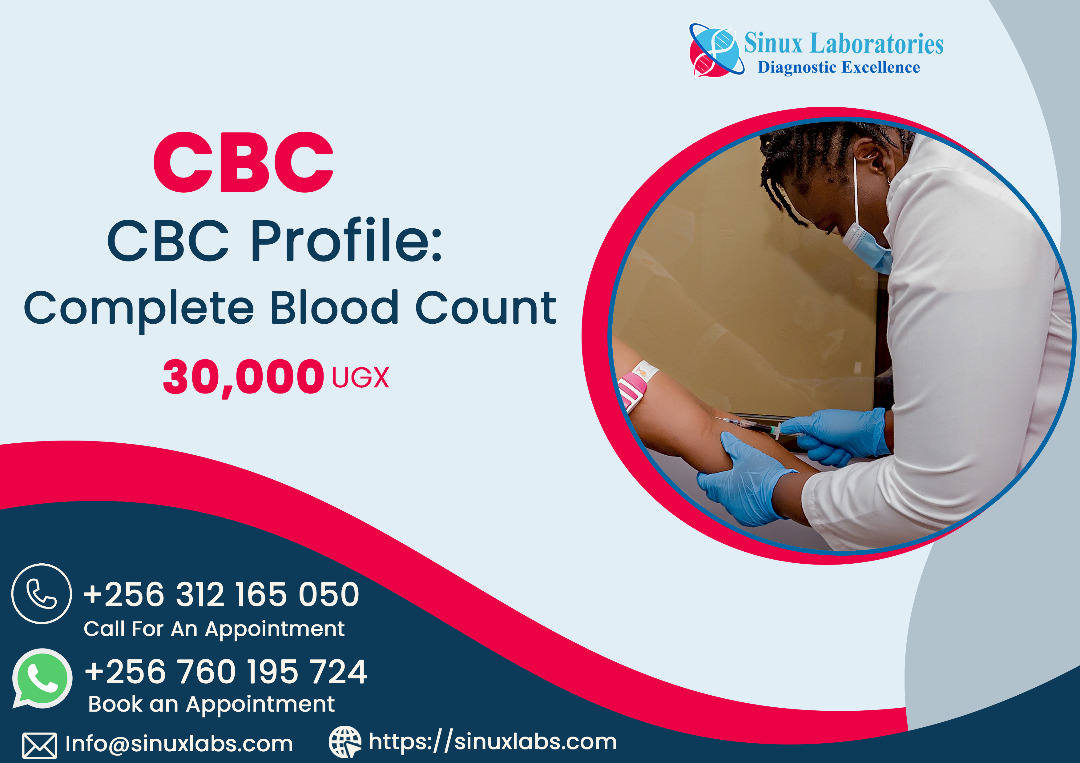- Test Name : Complete Blood Count
- Category : Health Check
- Where To do the Test : Bukoto Lab, Kirudu Lab & Mbale Lab

About This Test
To determine your general health status; to screen for, diagnose, or monitor any one of a variety of diseases and conditions that affect blood cells, such as anemia, infection, inflammation, bleeding disorder or cancer
When To Get Tested?
As part of a routine medical exam; when you have signs and symptoms that may be related to a condition that affects blood cells; at regular intervals to monitor treatment or disease status or when you are receiving treatment known to affect blood cells
What is being tested?
The complete blood count (CBC) is a group of tests that evaluate the cells that circulate in blood, including red blood cells (RBCs), white blood cells (WBCs), and platelets (PLTs). The CBC can evaluate your overall health and detect a variety of diseases and conditions, such as infections, anemia and leukemia.
Blood cells are produced and mature primarily in the bone marrow and, under normal circumstances, are released into the bloodstream as needed. The three types of cells evaluated by the CBC include:
Red blood cells, also called erythrocytes, are produced in the bone marrow and released into the bloodstream when they mature. They contain hemoglobin, a protein that transports oxygen throughout the body. The typical lifespan of an RBC is 120 days. Thus, the bone marrow must continually produce new RBCs to replace those that age and degrade or are lost through bleeding. A number of conditions can affect the production of new RBCs and/or their lifespan, in addition to those conditions that may result in significant bleeding.
RBCs normally are uniform in size and shape, but their appearance can be affected by a variety of conditions, such as vitamin B12 and folate deficiencies and iron deficiency. An example of a common condition affecting RBCs is anemia, which results from low red blood cell counts and low hemoglobin. Various diseases can lead to anemia, so additional tests are often needed to determine the cause. For more details, see the articles on Red Blood Cell Count, Hemoglobin, and Hematocrit.
White blood cells, also called leukocytes, are cells that exist in the blood, the lymphatic system, and tissues and are an important part of the body’s natural defense (immune) system. They help protect against infections and also have a role in inflammation, and allergic reactions. There are five different types of WBCs and each has a different function. They include neutrophils, lymphocytes, basophils, eosinophils, and monocytes.
WBCs are present in the blood at relatively stable numbers. However, these numbers may temporarily shift higher or lower depending on what is going on in the body. For instance, an infection can stimulate your bone marrow to produce a higher number of neutrophils to fight off a bacterial infection. With allergies, there may be an increased number of eosinophils. An increased number of lymphocytes may be produced with a viral infection. In certain diseases, such as leukemia, abnormal (immature or mature) white cells may rapidly multiply. For additional details, see the articles White Blood Cell Count and WBC Differential.
Platelets, also called thrombocytes, are actually tiny cell fragments that circulate in blood and are essential for normal blood clotting. When there is an injury and bleeding begins, platelets help stop bleeding by adhering to the injury site and clumping together to form a temporary plug. They also release chemical signals that attract and promote clumping of additional platelets and eventually become part of a stable blood clot at the site of the injury that remains in place until the injury heals.
If you have a disease or condition that causes low platelets (thrombocytopenia) or dysfunction of platelets, you may be at an increased risk of excessive bleeding and bruising. An excess of platelets (thrombocytosis) can cause excessive clotting. For more information, see the article Platelet Count.

